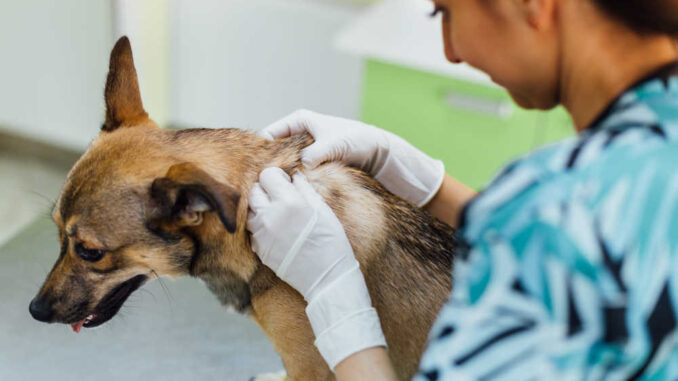
This article was updated on May 2nd, 2023
Finding a new lump or bump on your dog can be a heartstopping moment. For many owners, they’ll automatically jump to the worst case scenario in their minds. However, you need to remember that there are a wide range of potential considerations, most of which are easily treated or need no intervention.
A new lump should never be ignored and owners are advised to keep records of the size and shape of any new lump found. Monitoring them for any growth or change can help a vet determine what the next best steps are in the treatment plan. Whatever a new lump is, it is a trained vet who should be diagnosing it.
Types of lumps or bumps often found on a dog’s back
1. Lipoma
Lipomas are fatty lumps that typically grow slowly in older, overweight dogs. The skin over the lipoma should appear normal, as a lipoma would not be expected to cause any skin ulceration or infection.
A dog with one fatty lump will often develop more as they get older. In the picture below we can see an overweight dog who has what looks to be a lipoma near the dog’s back. The lump is quite symmetrical and the skin is not broken. These lumps tend to feel quite squishy, though larger lipomas may feel firm when pressed.
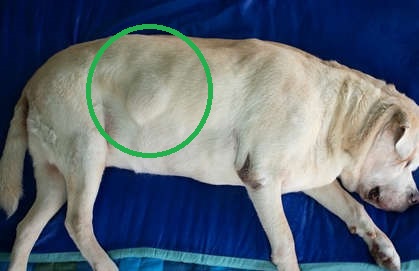
Most fatty lumps are not treated and we just monitor them to ensure they’re not causing the dog any problems. If a lipoma is very large or affecting mobility, surgery may be advised to remove it. Once removed, prognosis is good but lipomas can recur in the same place.Those on the back do not tend to need treatment. Learn more about lipomas in dogs.
2. Cyst
Cysts can contain liquid or solidified contents like sebum or dead skin cells. They can occur at any age and some dogs will be prone to them, developing many throughout their life. This cyst has a smooth appearance and is quite symmetrical:
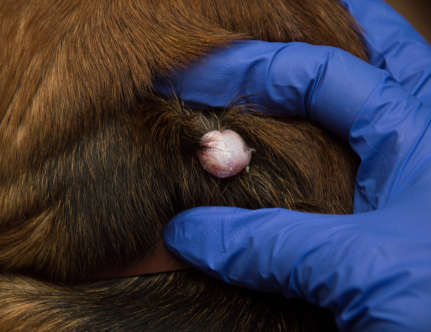
A vet may well suspect a cyst just by looking at the lump and they may suggest popping a needle in, to see if it drains and to analyze the contents. In some cases, the vet may be left unsure if it is a true cyst or not, so might suggest the lump is sampled or removed, to ensure it is nothing sinister. If a cyst is drained but not removed, it usually quickly refills. View pictures of 6 types of cysts in dogs and what to do.
3. Skin tag or ‘old age wart’
A skin tag or a wart is a growth of tissue that is non-cancerous and will often present on the back of senior dogs. While skin tags and warts can appear anywhere, we do regularly see them on the back of a dog. These lesions can be a range of colors and are generally fleshy and very slow growing. They will not cause the dog any pain and should not ulcerate (when the skin breaks on the surface).
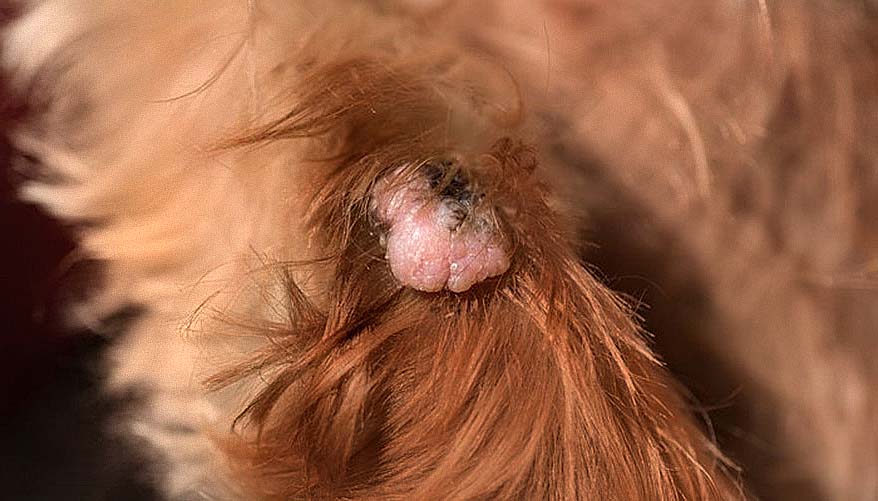
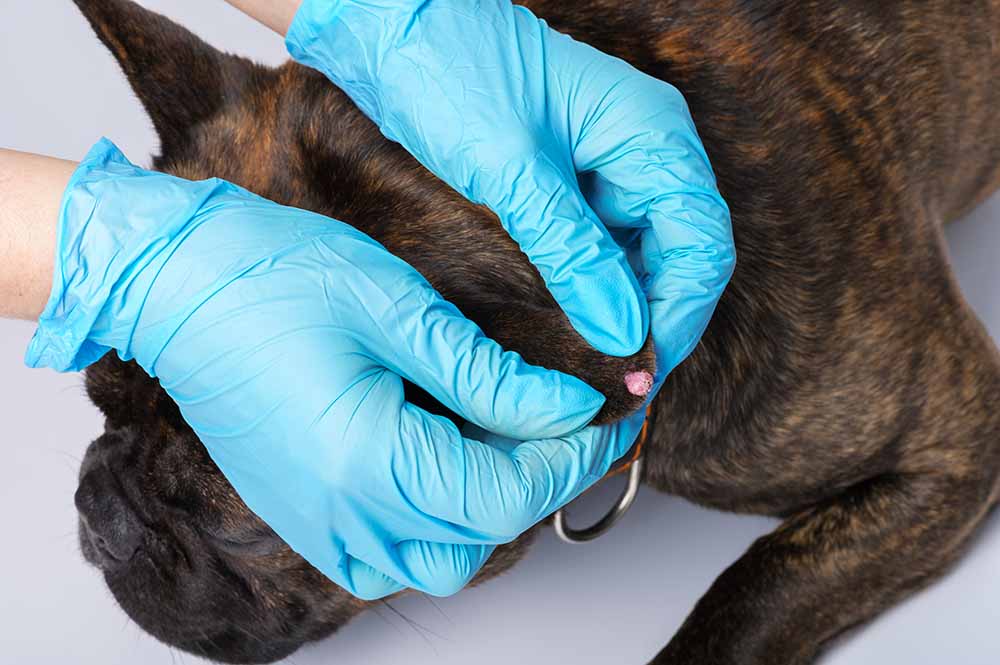
Sometimes the vet will be so confident that the lesion is a skin tag, they will just monitor it and won’t suggest it is biopsied. Other times, a sample is advised, if the vet has any doubt about what we could be dealing with. View more pictures of dog warts & dog skin tags with veterinarian advice. If you are not sure, you can also read our article: Is it a wart or a skin tag?).
4. Insect bite
An insect bite will show up and be gone all in the space of a few days. They tend to present as small red bumps and they may be a little itchy. Due to a dog’s thick coat, we may not always notice insect bites. Other than keeping them clean with salt water, these little bites need no specific treatment.
5. Abscess
An abscess is a build up of pus under the skin that can have several primary causes including a bite from another animal or a foreign body under the skin. When an abscess occurs on the back, we will usually feel a squishy swelling that may be hot to the touch. The dog will be sensitive in this area.
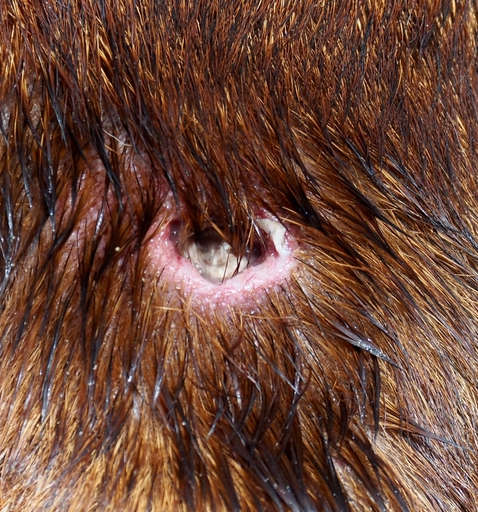
An abscess will be treated by clipping the surrounding fur, cleaning out the pus and providing a course of antibiotics and anti inflammatories. Most dogs recover well, with the infection clearing in less than a week.
6. Tick
A small and shiny lump that suddenly appears on your dog’s back may actually be a tick! These little arachnids are parasites that attach to your dog’s body and start to suck their blood. Importantly, they will fall off after about 5 days so if a lump has been there for some time, there is no chance it is a tick.
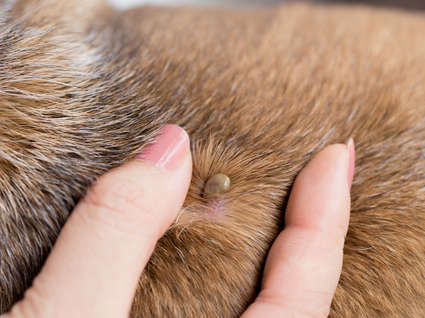
Above, we can see a brown tick on a dog’s back, that is oval shaped and has a smooth and shiny surface. If we were to look closer, we would be able to see black, skinny legs. You can also click here to view pictures of tick scabs or flea allergy and flea scabs.
A tick should be removed by twisting them using a tweezers or tick remover. Once removed, we should kill it by putting it in an egg cup of rubbing alcohol. They should not be squished as this is a potential means of spreading infection. Going forward, owners can prevent ticks with products like collars, tablets or spot ons provided by the vet.
7. Tumor
Of course, a new lump on the back could potentially be a tumor such as a mast cell tumor, sarcoma etc. While different types of tumors will act differently, as a general rule they will grow rapidly and can bleed and become infected. They will not usually cause the dog pain, at least when small. A new lump should always be examined by a vet, to rule cancer in or out.
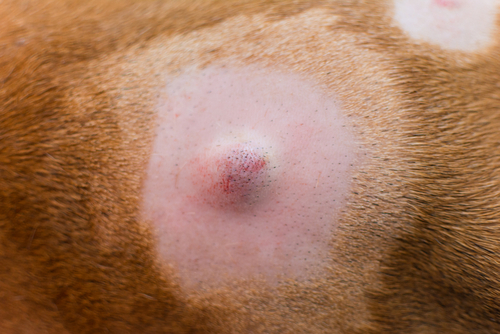
In the picture above, we can see a cancerous tumor on a dog’s back that has been prepped before surgical removal. For most tumors, we would get a diagnosis with an FNA or biopsy before removal, so surgery can be planned. After removing the growth, the vet should send it to the lab to ensure it has been completely excised. View pictures of cancerous skin lesions and lumps.
What to do when you find a lump or bump on your dog’s back
Finding a new lump or bump on your dog’s back when you are petting or grooming them can be a worrying experience. It is always sensible to get a professional’s opinion, especially if the lesion is growing or changing. A good rule of thumb is that a lump that has been present for more than 1-2 weeks is one we should have looked at. Or, any lump that is rapidly growing and changing or that is bleeding or causing the dog issues. Learn more on our lumps and bumps page.
When do you need veterinary help?
As mentioned, it is never wrong to seek a vet’s opinion when it comes to new back lumps. While many will be benign and won’t require much in the way of treatment, those that are cancerous need to be identified. With any cancer, the sooner it is diagnosed and treated, the better the prognosis.
Signs that your dog’s new bump need investigating
A bump or lump that is not shrinking and going away within 1-2 weeks should be looked into. We’d also worry for those lumps that are hard and knobbly, that are firmly attached to the skin and that are ulcerated, bleeding or infected.
Veterinary diagnosis
While an experienced vet may have a good idea of what a lump is from simply examining it, they cannot know for sure what it is without sending a sample to the lab. There are three main ways this is done:
FNA (Fine Needle Aspirate). A needle is put into the lump and some cells are aspirated out. These cells will be examined under the microscope. This method is the cheapest (about $120-200) and easiest (no need for anesthetic or sutures) but does not always yield a diagnosis as results can be inconclusive if not many cells have been aspirated.
Incisional Biopsy. Sometimes, the vet will cut out a small section of the lump with a blade or punch biopsy. This way, a larger proportion of cells can be analyzed by the lab and we’ll usually get a diagnosis. The hole may require one or two stitches to close up. This type of biopsy costs from $220-350.
Excisional Biopsy. In some instances, the vet will discuss removing the lump completely and sending this away to the lab. This can be a good idea if we want to avoid two separate procedures, if the lump is causing the dog issues or if we are highly suspicious of a cancer. As this is basically a lump removal, surgery costs from about $300-600, depending on the size of the growth.
Questions your vet may ask you
Your vet will want to know
- How long the lump has been present
- If the lump is discharging
- If your dog has been licking, scratching or chewing in the area
- If your dog has ever been diagnosed with cancer in the past
Common veterinary treatments
For many lumps like lipomas and skin tags, no treatment is needed and we will just keep an eye on the situation. For those lumps that are known or suspected to be cancer, we’ll usually biopsy them or may go ahead and remove them right away.
Disclaimer: This website's content is not a substitute for veterinary care. Always consult with your veterinarian for healthcare decisions. Read More.


Be the first to comment